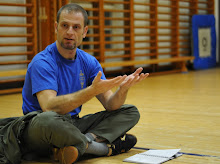 What follows is an excerpt from a book I read recently, and made quite an impression to me. The book is Ellis Amdur's Hidden in Plain Sight: Tracing the Roots of Ueshiba Morihei's Power. I want to make clear that I haven't ever trained in aikido, nor am I interested to. On the other side, I believe Morihei Ueshiba was one of the greatest martial artists of the twentieth century and also a great thinker, although limited by the era he lived in and the Japanese culture. I also consider Ellis Amdur an excellent writer and I especially appreciate the fact that he attributes Ueshiba's formidable power to his training and not to some supernatural energy he mysteriously tapped into.
What follows is an excerpt from a book I read recently, and made quite an impression to me. The book is Ellis Amdur's Hidden in Plain Sight: Tracing the Roots of Ueshiba Morihei's Power. I want to make clear that I haven't ever trained in aikido, nor am I interested to. On the other side, I believe Morihei Ueshiba was one of the greatest martial artists of the twentieth century and also a great thinker, although limited by the era he lived in and the Japanese culture. I also consider Ellis Amdur an excellent writer and I especially appreciate the fact that he attributes Ueshiba's formidable power to his training and not to some supernatural energy he mysteriously tapped into.Here's the excerpt:
" A person with 'locked' joints has 'handles' and 'levers' - when force vectors are applied, such an individual cannot absorb and flow with said forces, cannot channel them into the ground, or cause them to resonate and amplify within a trained body, and more importantly, send them back through himself into the aggressor. Such locked joints do not only occur within the physical body. Ueshiba shows the same understanding as Wilhelm Reich, Ida Rolf, and Moshe Feldenkrais, that physical 'handles' and 'levers' are associated with binding and limitation within the psychological structure. Even with the most dedicated practice of physical technique, one very possibly will remain psychologically distorted, something we have seen in even graceful, very powerful martial artists. Similarly, were one merely to chant, meditate, or otherwise strive to cleanse the 'psychological/spiritual' body, one might be quite at peace until one 'runs into' the world, something occurring again and again when spiritual teachers of quite high attainment meet the temptations of modern society with a body still hungry for that energy".
You can find more about Ellis Amdur's work (which includes much more that martial arts training and writing books) here: http://edgework.info/







Spyro, I agree with your post. There is one thing that I have been thinking about lately. Why does the dead man become rock-stiff? Why doesn't body become loosen without any tension. I mean, if body without active consciousness (or soul) becomes stiff, isn't logical to conclude that our psyche is making our body soft. Another thing. Is 100% unconscious person (in coma for example) completely soft, meaning without physical 'handles' and 'levers' you mention. Further more, this could lead us to thinking that we are soft by the brain command, consciously or unconsciously, and stiff areas show up when brain (or soul) turns a blind eye on keeping them soft? The area is rather complicated.
ReplyDelete@Milos:
ReplyDeleteFrom the wikipedia article on "Rigor Mortis"
"Rigor mortis is one of the recognizable signs of death (Latin mors, mortis meaning "of death") that is caused by a chemical change in the muscles after death, causing the limbs of the corpse to become stiff (Latin rigor) and difficult to move or manipulate. In humans it commences after about 3 hours, reaches maximum stiffness after 12 hours, and gradually dissipates until approximately 72 hours (3 days) after death."
We are naturally soft, we are mostly water, we are space between atoms. I think any tension has a psychological root, but i don't really know about these things.
Ellis Amdur is a good author and has a very interesting approach. Thank you for sharing you discoveries!